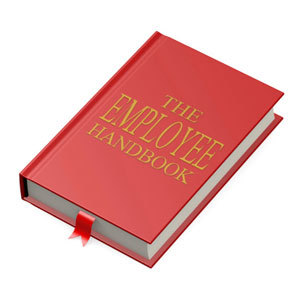Don’t Skip the Employee Handbook!
 Having a clear, well-organized employee handbook is a crucial element of the employer-employee relationship and a business’s operations. A well-constructed employee handbook can protect a business during 3rd party investigations, litigation and other costly legal woes. An employee handbook also helps all employees understand company policies and procedures. And finally, an employee handbook assists with ensuring the smooth operation of day-to-day business by establishing clear workplace rules and policies.
Having a clear, well-organized employee handbook is a crucial element of the employer-employee relationship and a business’s operations. A well-constructed employee handbook can protect a business during 3rd party investigations, litigation and other costly legal woes. An employee handbook also helps all employees understand company policies and procedures. And finally, an employee handbook assists with ensuring the smooth operation of day-to-day business by establishing clear workplace rules and policies.
A must-have for every business
Although handbooks are not required by law, every employer should have one, explains Rebecca Seaman, PHR, HR Pro with HRAnswerLink. “If you have 2 employees or 200 employees, you absolutely need a handbook. It communicates to employees very important things that demonstrate reasonable care,” says Seaman.
Having policies documented in a handbook provides evidence that an employer exercised reasonable care — that is, showed concern for and took steps to protect employees’ well-being. For example, explains Seaman, a handbook may state that the employer has a zero-tolerance policy for harassment and explain the procedure an employee should follow when he or she has experienced harassment.
“From a legal perspective, the burden of proof is always on the employer to prove that they didn’t do anything wrong. So if an employee says, ‘I was harassed and no one did anything about it,’ one of the first places to turn for a line of defense is the handbook,” Seaman says.
Elements of an effective handbook
Employee handbooks can include a variety of information. They can (and should) contain policies that federal and state laws require employers to follow as well as policies that are just good business sense. Here is a quick overview of the elements that make up an effective employee handbook.
Policies required by law. Federal or state laws require an employer to abide by certain policies, and these are best communicated to employees in writing. The handbook is a great mode of communication for these purposes. State-mandated policy requirements may vary from state to state, depending on where the employee is located, but these policies typically include
- Family Medical Leave Act (FMLA) policies
- Equal employment and non-discrimination policies (including harassment policies)
- Workers’ compensation policies
Clauses every handbook should have. Certain policies or clauses of an effective employee handbook are not necessarily mandated by law, but are still vital for businesses to include.
- Not a contract clause — explains that the employee handbook is not a contract or promise of continued employment. It also helps to preserve the at-will relationship.
- Current handbook supersedes all previous handbook versions and policies — clause that states that the current handbook trumps all previous versions or policy documents.
- Subject to change clause — indicates that policies are subject to change; this enables the employer to update policies and the handbook itself to comply with changes in law or company policies.
- Employee acknowledgment page — a page that indicates the employee has read and agrees to all terms in the handbook; the employee signs this page and returns it to the employer.
Business-specific clauses and policies. An employer may want to include additional clauses and policies in the handbook — for instance, benefits, paid time-off, attendance, employee behavior expectations, and others. Your clients will want to make sure nothing in these policies violates state or federal laws.
Keeping the handbook updated
HRAnswerLink’s HR Support Center recommends that employers review and update their employee handbook at least once a year to comply with changes in federal and state laws and emerging issues like social media use. Though it’s important to keep the handbook updated, doing so can be time-consuming — even more so for employers who have employees in several states. That’s because multi-state employers’ handbooks must include policies specific to employees in each state as well as policies that apply to all employees.
The HR Support Center solves that problem by offering resources that make it easy to create an employee handbook that complies with state and federal laws — and also keep the handbook updated. First, all HR Support Center users have access to the Policy Library, which contains more than 100 policy templates that users can copy and adapt for use in their own handbooks.
Additionally, for affiliates who have HR On-Demand activated for their clients, their clients have access to the handbook development feature. This includes basic handbook templates as well as access to an HR Pro who will review the handbook to ensure it complies with both federal and all applicable state laws.
A great sales tool for affiliates
The handbook development feature in HR On-Demand is a great selling tool for HRAnswerLink affiliates and really sets the HR Support Center apart from competitors. “Competitors will typically sell the handbook anywhere from $700 to even $4,000 to $5,000 (depending on number of states they’re doing business in),” says Seaman. “With our service, affiliates have the handbook service available at the low HR On-Demand price. It doesn’t matter if you do business in one state or 25, we’re going to make sure that client is taken care of.”
Having an employee handbook should never be optional — and HR On-Demand makes it easy to create one and keep it up to date. No one can offer handbook services for the price HRAnswerLink affiliates can — a definite competitive edge!
[cta]Questions or comments? Let us know your thoughts. Contact HRAnswerLink on our website, by phone at (877) 882-2237, or by email.[/cta]
